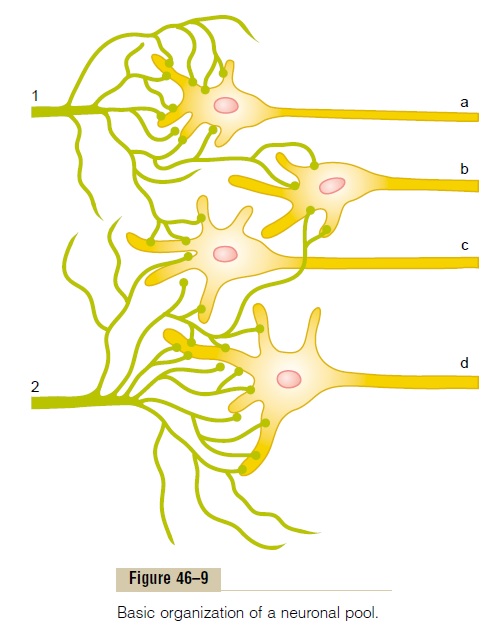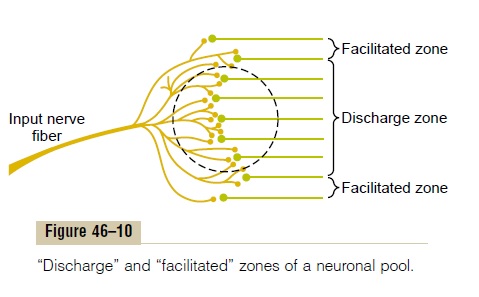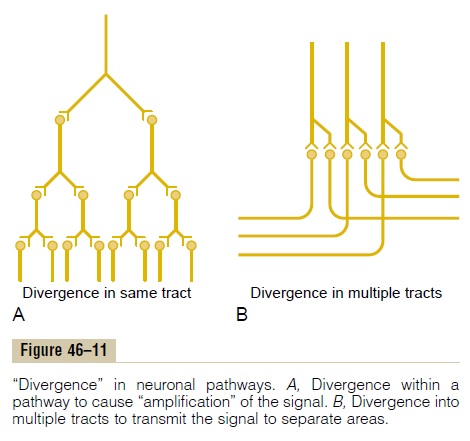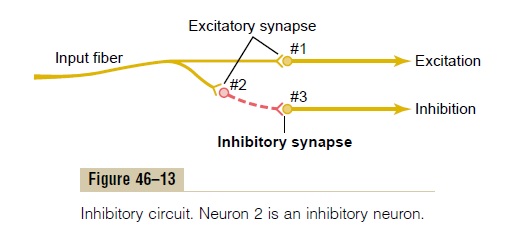Chapter: Medical Physiology: Sensory Receptors, Neuronal Circuits for Processing Information
Relaying of Signals Through Neuronal Pools
Relaying of Signals Through Neuronal Pools
Organization of Neurons for Relaying Signals. Figure 46–9 isa schematic diagram of several neurons in a neuronal pool, showing “input” fibers to the left and “output” fibers to the right. Each input fiber divides hundreds to thousands of times, providing a thousand or more terminal fibrils that spread into a large area in the pool to synapse with dendrites or cell bodies of the neurons in the pool. The dendrites usually also arborize and spread hundreds to thousands of micrometers in the pool.
The neuronal area stimulated by each incoming nerve fiber is called its stimulatory field. Note in Figure 46–9 that large numbers of the terminals from each input fiber lie on the nearest neuron in its “field,” but progressively fewer terminals lie on the neurons farther away.

Threshold and Subthreshold Stimuli—Excitation or Facilitation. From the discussion of synaptic function, it will be recalled that discharge of a single excitatory presynaptic terminal almost never causes an action potential in a postsynaptic neuron. Instead, large numbers of input terminals must discharge on the same neuron either simultaneously or in rapid suc-cession to cause excitation. For instance, in Figure 46–9, let us assume that six terminals must discharge almost simultaneously to excite any one of the neurons. If the student counts the number of terminals on each one of the neurons from each input fiber, he or she will see that input fiber 1 has more than enough terminals to cause neuron a to discharge. The stimulus from input fiber 1 to this neuron is said to be an excitatory stimulus; it is also called a suprathreshold stimulus because it is above the threshold required forexcitation.
Input fiber 1 also contributes terminals to neurons b and c, but not enough to cause excitation. Never-theless, discharge of these terminals makes both these neurons more likely to be excited by signals arriving through other incoming nerve fibers. Therefore, the stimuli to these neurons are said to be subthreshold, and the neurons are said to be facilitated.
Similarly, for input fiber 2, the stimulus to neuron d is a suprathreshold stimulus, and the stimuli to neuronsb and c are subthreshold, but facilitating, stimuli.
Figure 46–9 represents a highly condensed version of a neuronal pool because each input nerve fiber usually provides massive numbers of branching termi-nals to hundreds or thousands of neurons in its distri-bution “field,” as shown in Figure 46–10. In the central portion of the field in this figure, designated by the circled area, all the neurons are stimulated by the incoming fiber. Therefore, this is said to be the dis-charge zone of the incoming fiber, also called the excited zone or liminal zone. To each side, the neuronsare facilitated but not excited, and these areas are called the facilitated zone, also called the subthresholdzone or subliminal zone.

Inhibition of a Neuronal Pool. We must also rememberthat some incoming fibers inhibit neurons, rather than exciting them. This is the opposite of facilitation, and the entire field of the inhibitory branches is called the inhibitory zone. The degree of inhibition in the centerof this zone is great because of large numbers of endings in the center; it becomes progressively less toward its edges.
Divergence of Signals Passing Through Neuronal Pools
Often it is important for weak signals entering a neu-ronal pool to excite far greater numbers of nerve fibers leaving the pool. This phenomenon is called diver-gence. Two major types of divergence occur and haveentirely different purposes.
An amplifying type of divergence is shown in Figure 46–11A. This means simply that an input signal spreads to an increasing number of neurons as it passes through successive orders of neurons in its path. This type of divergence is characteristic of the corticospinal pathway in its control of skeletal muscles, with a single large pyramidal cell in the motor cortex capable, under highly facilitated conditions, of exciting as many as 10,000 muscle fibers.

The second type of divergence, shown in Figure 46–11B, is divergence into multiple tracts. In this case, the signal is transmitted in two directions from the pool. For instance, information transmitted up the dorsal columns of the spinal cord takes two courses in the lower part of the brain: (1) into the cerebellum and (2) on through the lower regions of the brain to the thalamus and cerebral cortex. Likewise, in the thala-mus, almost all sensory information is relayed both into still deeper structures of the thalamus and at the same time to discrete regions of the cerebral cortex.
Convergence of Signals
Convergence means signals from multiple inputsuniting to excite a single neuron. Figure 46–12A shows convergence from a single source. That is, multiple ter-minals from a single incoming fiber tract terminate on the same neuron. The importance of this is that neurons are almost never excited by an action poten-tial from a single input terminal. But action potentials converging on the neuron from multiple terminals provide enough spatial summation to bring the neuron to the threshold required for discharge.

Convergence can also result from input signals (exci-tatory or inhibitory) from multiple sources, as shown in Figure 46–12B. For instance, the interneurons of the spinal cord receive converging signals from (1) periph-eral nerve fibers entering the cord, (2) propriospinal fibers passing from one segment of the cord to another, (3) corticospinal fibers from the cerebral cortex, and (4) several other long pathways descend-ing from the brain into the spinal cord.Then the signals from the interneurons converge on the anterior motor neurons to control muscle function.
Such convergence allows summation of information from different sources, and the resulting response is a summated effect of all the different types of informa-tion. Convergence is one of the important means by which the central nervous system correlates, sum-mates, and sorts different types of information.
Neuronal Circuit with Both Excitatory and Inhibitory Output Signals Sometimes an incoming signal to a neuronal pool causes an output excitatory signal going in one direc-tion and at the same time an inhibitory signal going elsewhere. For instance, at the same time that an exci-tatory signal is transmitted by one set of neurons in the spinal cord to cause forward movement of a leg, an inhibitory signal is transmitted through a separate set of neurons to inhibit the muscles on the back of the leg so that they will not oppose the forward move-ment. This type of circuit is characteristic for control-ling all antagonistic pairs of muscles, and it is called the reciprocal inhibition circuit.

Figure 46–13 shows the means by which the inhibi-tion is achieved. The input fiber directly excites the excitatory output pathway, but it stimulates an inter-mediate inhibitory neuron (neuron 2), which secretes a different type of transmitter substance to inhibit the second output pathway from the pool. This type of circuit is also important in preventing overactivity in many parts of the brain.
Related Topics